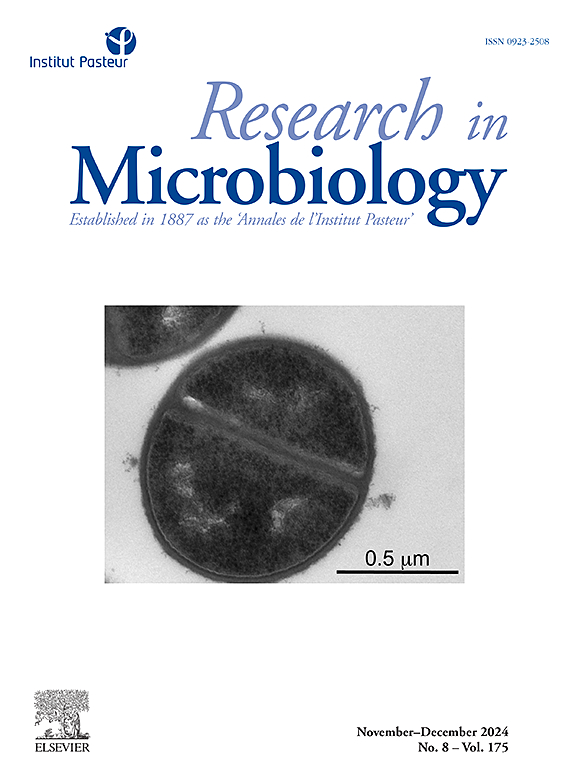Biosynthetic capabilities of Antarctic yeast Sporobolomyces roseus AL103: Temperature influence on intracellular metabolites and characterization of the exopolysaccharide
IF 3.4
4区 生物学
Q3 MICROBIOLOGY
引用次数: 0
Abstract
The purpose of the study was to investigate the biosynthetic properties of the Antarctic yeast strain Sporobolomyces roseus AL103 in response to temperature changes, to perform intracellular metabolic profiling, and to reveal the chemical and functional characteristics of the synthesized exopolysaccharide (EPS). The results show that the yeast strain needed a shorter time to reach a stationary phase at 22 °C contrary to that of 5 °C. An NMR analysis revealed differences in metabolic profiles of amino acids, glucose, trehalose, glycerol, uridine, etc. EPS (2.9 g/L) was characterized by high–molecular-weight with total carbohydrate, uronic acids, and protein content of 66 %, 10.5 %, and 2.5 %, respectively. Mannose (74 mol%) and galactose (19 mol%) were the major constituents. The FT-IR data suggested the presence of β-(1–4)-mannan. DSC thermogram, WVTR, mechanical properties, and moisture sorption of the EPS film showed thermal stability up to 220 °C and hydrophilic behavior. The newly obtained polymer film was studied for the first time and the data showed possibilities for its successful application as a film-forming material in the preparation of packaging materials. In conclusion, the temperature influenced the metabolic profile of the Antarctic yeast producer. The biotechnological process could be directed to obtain the target intracellular or extracellular metabolites.

南极酵母 Sporobolomyces roseus AL103 的生物合成能力:温度对胞内代谢物的影响和外多糖的特征。
本研究旨在研究南极酵母菌株 Sporobolomyces roseus AL103 对温度变化的生物合成特性,进行细胞内代谢分析,并揭示合成的外多糖(EPS)的化学和功能特性。结果表明,酵母菌株在 22 ℃ 达到静止期所需的时间比在 5 ℃ 达到静止期所需的时间短。核磁共振分析表明,氨基酸、葡萄糖、三卤糖、甘油、尿苷等代谢谱存在差异。EPS(2.9 克/升)具有高分子量的特点,总碳水化合物、尿酸和蛋白质含量分别为 66%、10.5% 和 2.5%。主要成分是甘露糖(74 摩尔%)和半乳糖(19 摩尔%)。傅立叶变换红外光谱数据表明存在β-(1-4)-甘露聚糖。EPS 薄膜的 DSC 热图、WVTR、机械性能和吸湿性能表明,其热稳定性可达 220 ℃,并具有亲水性。对新获得的聚合物薄膜进行了首次研究,研究数据表明,该薄膜可成功用作制备包装材料的成膜材料。总之,温度影响了南极酵母生产者的新陈代谢曲线。生物技术过程可以定向获得目标细胞内或细胞外代谢物。
本文章由计算机程序翻译,如有差异,请以英文原文为准。
求助全文
约1分钟内获得全文
求助全文
来源期刊

Research in microbiology
生物-微生物学
CiteScore
4.10
自引率
3.80%
发文量
54
审稿时长
16 days
期刊介绍:
Research in Microbiology is the direct descendant of the original Pasteur periodical entitled Annales de l''Institut Pasteur, created in 1887 by Emile Duclaux under the patronage of Louis Pasteur. The Editorial Committee included Chamberland, Grancher, Nocard, Roux and Straus, and the first issue began with Louis Pasteur''s "Lettre sur la Rage" which clearly defines the spirit of the journal:"You have informed me, my dear Duclaux, that you intend to start a monthly collection of articles entitled "Annales de l''Institut Pasteur". You will be rendering a service that will be appreciated by the ever increasing number of young scientists who are attracted to microbiological studies. In your Annales, our laboratory research will of course occupy a central position, but the work from outside groups that you intend to publish will be a source of competitive stimulation for all of us."That first volume included 53 articles as well as critical reviews and book reviews. From that time on, the Annales appeared regularly every month, without interruption, even during the two world wars. Although the journal has undergone many changes over the past 100 years (in the title, the format, the language) reflecting the evolution in scientific publishing, it has consistently maintained the Pasteur tradition by publishing original reports on all aspects of microbiology.
 求助内容:
求助内容: 应助结果提醒方式:
应助结果提醒方式:


